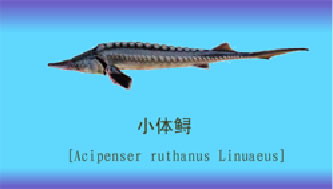Acipenser
ruthenus
Linnaeus,
1758
Sterlet sturgeon
View all media / Upload your photos and videos
Expand all
Classification / Names
Chondrostei (sturgeons) > Acipenseriformes (Sturgeons and paddlefishes) >
Acipenseridae (Sturgeons)
> Acipenserinae
Etymology: Acipenser: Latin, acipenser = sturgeon, 1853 (Ref. 45335).
More on author:
Linnaeus.
Environment / milieu / depth range / climate zone / distribution range
Distribution
Eurasia: rivers draining to Black, Azov and Caspian Seas; Siberia from Ob eastward to Yenisei drainages. Introduced throughout Europe, without formation of self-sustaining populations.
Length at first maturity / Size / Weight / Age
Short description
Dorsal spines (total): 13; Dorsal soft rays (total): 28; Anal spines: 9; Anal soft rays: 14 - 18. Back and flanks are beige. Five rows of scutes : 12-17D, 57-71L, 10-19V. Ventrals and laterals are very light-colored, nearly white. Narrow and pointed snout with four long and fringed barbels. Inferior lip clearly slit (Ref. 40476). Can be diagnosed from congeners in Europe by having 56-71 lateral scutes, first dorsal scute not fused with head, barbels fimbriate, lower lip interrupted in middle and 11-27 gill rakers (Ref. 59043).
Biology
A fluvial fish which inhabits rivers and their tributaries (Ref. 9696). Occurs in large rivers, usually in the current and in deep water. Moves to flooded areas to feed (Ref. 59043). Chiefly potamodromous (Ref. 58897). Like other sturgeons, it aggregates in bottom holes in winter and exhibits little activity. In spring, when ice breaks, it rises from the bottom holes and moves upstream for spawning (Ref. 593). Spawns in habitats with strong-current on gravel, rarely on gravel-sand bottom or in flooded sites. Juveniles stay in riverine habitats during their first summer. Classified as endangered species. Anadromous populations are now extirpated; local populations are still surviving in most parts of range (Ref. 59043).
Life cycle and mating behavior
Scatters eggs on gravel.
Main reference
Birstein, V.J. 1993 Sturgeons and paddlefishes: threatened fishes in need of conservation. Conserv. Biol. 7:773-787. (Ref. 6866)
IUCN Red List Status (Ref. 125652)
Endangered (EN), A2cde; date assessed: September 14 2019
CITES (Ref. 131153)
Appendix II: International trade monitored
CMS (Ref. 116361)
Appendix II: Migratory species conserved through agreements
Threat to humans
Harmless
More information
- Countries
- FAO areas
- Ecosystems
- Occurrences
- Introductions
- Stocks
- Ecology
- Diet
- Food items
- Food consumption
- Ration
- Common names
- Synonyms
- Metabolism
- Predators
- Ecotoxicology
- Reproduction
- Maturity
- Spawning
- Spawning aggregation
- Fecundity
- Eggs
- Egg development
- Age/Size
- Growth
- Length-weight
- Length-length
- Length-frequencies
- Morphometrics
- Morphology
- Larvae
- Larval dynamics
- Recruitment
- Abundance
- References
- Aquaculture
- Aquaculture profile
- Strains
- Genetics
- Allele frequencies
- Heritability
- Diseases
- Processing
- Mass conversion
- Vision
- Pictures
- Stamps, Coins Misc.
- Sounds
- Ciguatera
- Speed
- Swim. type
- Gill area
- Otoliths
- Brains
Estimates based on models
Phylogenetic diversity index (Ref. 82804): PD50 = 0.5 [Uniqueness, from 0.5 = low to 2.0 = high].
Bayesian length-weight: a=0.00135 (0.00077 - 0.00235), b=3.27 (3.12 - 3.42), in cm total length, based on LWR estimates for this species & Genus-body shape (Ref. 93245).
Trophic level (Ref. 69278): 3.6 ±0.4 se; Based on diet studies.
Generation time: 13.2 ( na - na) years. Estimated as median ln(3)/K based on 2 growth studies.
Resilience (Ref. 120179): Very low, minimum population doubling time more than 14 years (tm=5-9; tmax=36; K=0.12; Fec=11,000).
Fishing vulnerability (Ref. 59153): High to very high vulnerability (73 of 100).
Climate vulnerability (Ref. 125649): High to very high vulnerability (67 of 100).
Price category (Ref. 80766): Unknown.
Nutrients (Ref. 124155): Calcium = 22.4 [14.3, 37.4] mg/100g; Iron = 0.282 [0.181, 0.425] mg/100g; Protein = 17.6 [15.0, 20.2] %; Omega3 = 0.408 [0.247, 0.673] g/100g; Selenium = 17.9 [10.1, 32.5] μg/100g; VitaminA = 7.74 [3.10, 18.84] μg/100g; Zinc = 0.519 [0.391, 0.693] mg/100g (wet weight);







